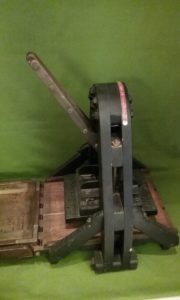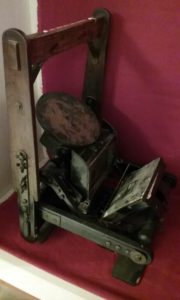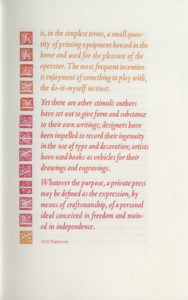Lasting Impressions: Printing from the Fifteenth Century to Today
In the basement of Swem Library is a room used mostly for storage. Along two walls are machines and wooden cases full of drawers. The machines are printing presses and the cases are filled with type – individual letters cast in metal, designed to be set by hand and printed on the machines. The basic principle--of metal type used in a press--was a technology in use for five hundred years in the West, from the mid-fifteenth century until the twentieth. Now, however, our printing is done by different machines, with jets of ink replacing the metal letters of the past. An upcoming exhibition at Swem Library examines printing from the early days to the present, using some actual equipment, as well as early modern rare books and modern day private press books, all from Special Collections.


Two of the presses held by Special Collections were actually made from scratch by Ralph Green in his workshop. He was also the man responsible for building one of the common presses at Colonial Williamsburg’s Printing Office, and it is still in use on a daily basis. The Special Collections presses are unusual: truly unique, they were made to prove that it was indeed possible to make presses that worked (and still do) using nothing more than the tools in a home workshop.
These are not, however, representative of most printing presses. The early modern books on show for the exhibition were made on something rather closer to what is called a common press. These are the presses operating at Colonial Williamsburg and are of the type featured in Diderot’s famous Encyclopédie, of which William & Mary Libraries has a complete first edition.
![[Diderot, d’Alembert, et al.], Encyclopédie: ou Dictionnaire raisonné des sciences, des arts et des métiers… Recueil de planches, sur les sciences, les arts libéraux, et les arts méchaniques, avec leur explication, 7me volume, Paris, 1769, Rare Book 034 En1b V.7.](https://libraries.wm.edu/sites/default/files/images/scrc-archive/2016/12/press-3-300x185.jpg)
The more modern private press books in the exhibition, however, have been made on commercially available presses and generally on a far smaller scale. This allows those who participate in the making of such books to give much more attention to detail and to use materials which are themselves special. Many of the books in the Vinyard Collection of private press books fit into this category, being printed in small runs on unusual papers, and hand-bound with other beautiful materials.
Even in our digital age printing with type on presses continues, and in it we may find a way to continue to express the desire for permanence which has always gone hand-in-hand with writing and printing.
(A preview of ‘Lasting Impressions: Printing from the Fifteenth Century to Today’ is on display in the second floor rotunda of Swem Library. The full exhibition will be on display in the new year.)
Written by Phillip Emanuel, Graduate Student Apprentice


